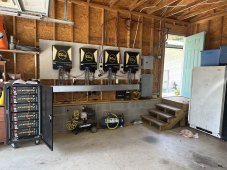TurbineTester
New Member
- Joined
- Apr 1, 2021
- Messages
- 143
I have 6 100 Ah Lifepower4 batteries connected to 4 inverters running split phase, 2 in each phase. Up until this last week I was running the same setup but on only 2 inverters. I could Tun my whole house on those two inverters with mostly no problem if we were careful about running high appliances at the same time. Dryer and water heater and coffee pot was big No. The house AC would run in this configuration but it would constantly trip the GFCI outlet in our bathroom. Occasionally either a dryer or microwave or AC starting would overload the inverters and the power would shut off until they auto restarted 5-10 seconds. We got tired of dealing with trying to balance loads so I got the two additional inverters. Now, however, when the AC comes on it’s about a 50/50 shot as to whether or not we actually fault out the batteries. This is super frustrating because then the entire system has to be completely manually shut down and restarted in order. Every AC in/out breaker and every single battery breaker and then whole system has to be restarted in order. These batteries should be able to handle the inrush of this compressor turning on right? I mean if I have a hard start installed on the ac ( which we do) and 6 freaking batteries with surge capacity of over 1,000 amps in total, I don’t understand why they are shutting down. Now we can be at a moderate load of around 5000w and the AC kicks in and the house is dark for dozens of minutes while a restart everything. Used to be it would just kick over to grid power and the lights would flicker. Now we are dark and grumbly in our house. Super frustrating. Please help me stop tripping the batteries and any suggestions welcome.
Thanks in advance.
Chris
Thanks in advance.
Chris




